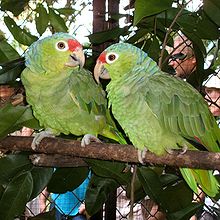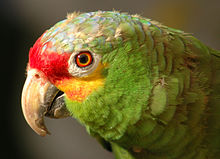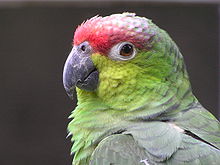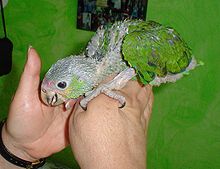- Red-lored Amazon
-
Red-lored Amazon 
At Xcaret Eco Park, Mexico Conservation status Scientific classification Kingdom: Animalia Phylum: Chordata Class: Aves Order: Psittaciformes Family: Psittacidae Genus: Amazona Species: A. autumnalis Binomial name Amazona autumnalis
(Linnaeus, 1758)The Red-lored Amazon or Red-lored Parrot (Amazona autumnalis) is a species of Amazon parrot, native to tropical regions of the Americas, from eastern Mexico south to Ecuador, with a disjunct population in central Brazil, where it occurs in humid evergreen to semi-deciduous forests up to 1,100 m altitude. It is absent from the Pacific side of Central America north of Costa Rica. Not originally known from El Salvador, a pair - perhaps escaped from captivity - nested successfully in 1995 and 1996 in the outskirts of San Salvador[1] and the species might expand its range permanently into that country in the future.[2]
Contents
Description
The Red-lored Amazon is 32–35 cm (13 in) in length, with a weight of 310–480 g. The plumage is primarily green, with a red forehead and, in some subspecies, yellow cheeks (sometimes with red spots). The crown is blue. Adult males and females do not differ in plumage. Juveniles have less yellow on the cheeks, less red on the forehead, and dark irises.
Taxonomy
There are four subspecies:[3]
- Amazona autumnalis autumnalis (Linnaeus, 1758). Caribbean coasts from eastern Mexico south to northern Nicaragua.
- Amazona autumnalis salvini (Salvadori, 1891). Northern Nicaragua south to Colombia and Venezuela.
- Amazona autumnalis lilacina (Lesson, 1844), the Lilacine Amazon. Western Ecuador.
- Amazona autumnalis diadema (Spix, 1824), the Diademed Amazon. Lower Rio Negro area, central Brazil.
Behavior
Food and feeding
Their food includes fruits,[4] nuts and seeds. Avoid feeding these guys Seeds, they are pron to weight problems.
Breeding
The Red-lored Amazon nests in tree cavities. The eggs are white and there are usually three or four in a clutch. The female incubates the eggs for about 26 days and the chicks leave the nest about 60 days after hatching.[5]
Status
In some areas, notably parts of Mexico and Venezuela, the Red-lored Amazon has become rare through trapping for the cagebird trade. On the other hand, it seems to be able to adapt to human-altered habitat to a considerable degree.[2]
Aviculture
Red-lored Amazons are fairly common pet parrots in the Americas. They can be devoted pets and some make fairly good talkers. Like most Amazon parrots they often have a tendency to vocalize loudly, and sometimes to bite. Their behavior ranges from being quiet and curious to being aggressive, this can all be changed by basic training when the bird is of young age.
Avocado and eggplant are poisonous to them (as they are for many parrots and other animals).
References
- ^ At San Jacinto Hill, 13°42'N 89°08'W: Herrera et al. (2006).
- ^ a b Herrera et al. (2006)
- ^ "Zoological Nomenclature Resource: Psittaciformes (Version 9.004)". www.zoonomen.net. 2008-07-05. http://www.zoonomen.net/avtax/psit.html.
- ^ E.g. of Cymbopetalum mayanum (Annonaceae), Gumbo-limbo (Bursera simaruba), mango (Mangifera indica), figs (Ficus spp.) and palo de hule (Castilla elastica): Herrera et al. (2006), Forster (2007).
- ^ Alderton, David (2003). The Ultimate Encyclopedia of Caged and Aviary Birds. London, England: Hermes House. p. 233. ISBN 184309164X.
- BirdLife International (2004). Amazona autumnalis. 2006. IUCN Red List of Threatened Species. IUCN 2006. www.iucnredlist.org. Retrieved on 12 May 2006. Database entry includes justification for why this species is of least concern.
- Collar, Nigel J. (1997): 313. Red-lored Amazon. In: del Hoyo, Josep; Elliott, Andrew & Sargatal, Jordi (eds.): Handbook of Birds of the World, Volume 4 (Sandgrouse to Cuckoos): 469-470, Plate 54. Lynx Edicions, Barcelona. ISBN 84-87334-22-9
- Foster, Mercedes S. (2007): The potential of fruiting trees to enhance converted habitats for migrating birds in southern Mexico. Bird Conservation International 17(1): 45-61. doi:10.1017/S0959270906000554 PDF fulltext
- Herrera, Néstor; Rivera, Roberto; Ibarra Portillo, Ricardo & Rodríguez, Wilfredo (2006): Nuevos registros para la avifauna de El Salvador. ["New records for the avifauna of El Salvador"]. Boletín de la Sociedad Antioqueña de Ornitología 16(2): 1-19. [Spanish with English abstract] PDF fulltext
External links
- World Parrot Trust Parrot Encyclopedia - Species Profiles
Amazon parrots (genus: Amazona) Species Cuban Amazon (or Rose-throated Amazon) • Yellow-billed Amazon (or Jamaican Amazon) • Hispaniolan Amazon • Puerto Rican Amazon • Yucatan Amazon (or Yellow-lored Amazon) • White-fronted Amazon • Black-billed Amazon • Tucuman Amazon • Red-spectacled Amazon • Red-crowned Amazon • Lilac-crowned Amazon • Red-lored Amazon (supporting page: Lilacine Amazon) • Blue-cheeked Amazon • Red-browed Amazon • Red-tailed Amazon • Festive Amazon • Yellow-shouldered Amazon • Blue-fronted Amazon (or Turquoise-fronted Amazon) • Yellow-crowned Amazon (supporting page: Panama Amazon) • Yellow-naped Amazon • Yellow-headed Amazon • Kawall's Amazon • Orange-winged Amazon • Scaly-naped Amazon • Mealy Amazon • Vinaceous-breasted Amazon (or Vinaceous Amazon) • St. Lucia Amazon • Red-necked Amazon • St. Vincent Amazon • Imperial AmazonHypothetical
extinct speciesCategories:- IUCN Red List least concern species
- Amazon parrots
- Birds kept as pets
- Birds of Brazil
- Birds of Central America
- Birds of Colombia
- Birds of Ecuador
- Native birds of Eastern Mexico
Wikimedia Foundation. 2010.






